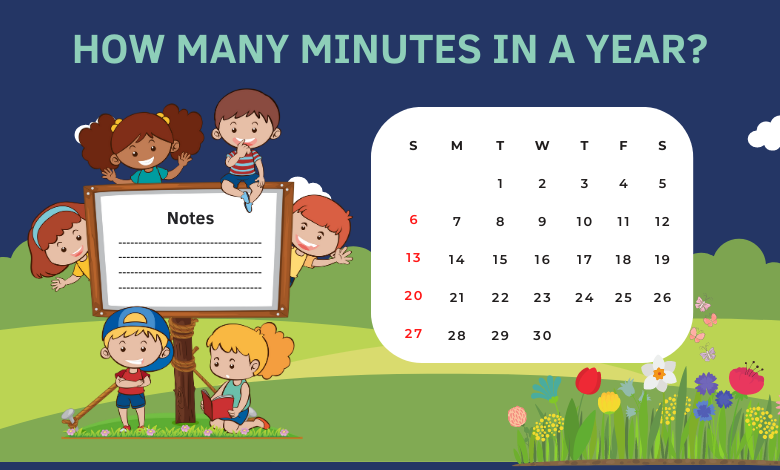How Many Minutes in a Year? (Use Our Online Converter)

If you’ve ever wondered how many minutes are in a year, you’re not alone. Many people encounter this question when dealing with time-based calculations, whether it’s for a project, personal planning, or just out of curiosity. Fortunately, it’s simple to calculate, and with modern tools like online converters, it’s easier than ever. Let’s dive into everything you need to know about how many minutes are in a year, how to perform the calculation, and the importance of leap years.
How Many Minutes in a Year?
If you’ve ever wondered how many minutes are in a year, the answer might surprise you with its simplicity. A regular, non-leap year consists of 365 days. To calculate the total number of minutes in a year, follow this straightforward calculation:
365 days × 24 hours/day × 60 minutes/hour = 525,600 minutes.
So, a regular year contains exactly 525,600 minutes. This figure assumes you’re working with a typical 365-day year, which is the case for most years. However, not every year is the same. There’s also the factor of leap years, which we’ll discuss a bit later.
How Do You Calculate Year to Minutes?
Calculating the number of minutes in a year is a simple process involving basic multiplication. Start by knowing the number of days in a year (365 days for a regular year). From there, multiply:
- 365 days (or 366 for a leap year)
- Multiply by 24 hours in each day
- Multiply by 60 minutes in each hour
For example, to calculate how many minutes are in a standard year:
365 days × 24 hours/day = 8,760 hours
8,760 hours × 60 minutes/hour = 525,600 minutes.
This gives you the total number of minutes in a typical year. If it’s a leap year, the total will be slightly higher.
Use Our Online Converter to Calculate Minutes in a Year
To simplify the process of calculating how many minutes are in a year, we offer an easy-to-use online time converter. Rather than spending time doing the math manually, our tool allows you to quickly convert days into minutes with just a few clicks.
Enter the number of years:
Steps to Use the Minutes in a Year Converter:
- Access the Converter: Head over to the “How Many Minutes in a Year?” page on WordPlop.
- Locate the Conversion Tool: Scroll down to find the section that says, “Enter the number of years.”
- Enter the Number of Years: Input the number of years you’d like to convert to minutes.
- Choose the Time Unit: From the dropdown menu, select “Minute” as the unit for conversion.
- Start the Conversion: Click on the “Convert Year to Minute” button to get your result.
- View the Result: The converter will quickly display the number of minutes in the entered years.
This makes it much easier to calculate how many minutes are in a year or any number of years without doing the math yourself.
How to Convert Minutes to Years
While many people need to know how many minutes are in a year, others might want to reverse the process and calculate how many years are in a given number of minutes. Converting minutes to years is just as easy.
To convert minutes into years, divide the total minutes by the number of minutes in a year. Since a standard year has 525,600 minutes, the formula to convert minutes to years is:
Total Minutes ÷ 525,600 = Number of Years.
For example, if you had 1,051,200 minutes, you would divide that by 525,600:
1,051,200 ÷ 525,600 = 2 years.
This way, you can quickly determine how many years correspond to a specific number of minutes.
What Is a Leap Year?
A leap year is a year that contains one additional day to keep our calendars aligned with the Earth’s revolutions around the Sun. Normally, a year has 365 days, but every four years, we add an extra day to February, making it 29 days instead of the usual 28. This extra day accounts for the fact that a year is actually 365.2425 days long, not exactly 365 days.
Leap years happen every four years, but there is an exception to the rule:
- If a year is divisible by 100 but not by 400, it is not a leap year.
- For example, the year 2000 was a leap year because it’s divisible by 400, but 1900 was not, even though it is divisible by 100.
How Many Minutes in a Leap Year?
In a leap year, which consists of 366 days, there are more minutes than in a standard year. A leap year has 527,040 minutes. Here’s the calculation:
366 days × 24 hours/day × 60 minutes/hour = 527,040 minutes.
So, while a regular year has 525,600 minutes, a leap year has an additional 1,440 minutes (since one extra day is added).
How Do You Calculate Minutes in Leap Years?
To calculate how many minutes are in a leap year, you simply take the formula for a regular year and adjust it for the extra day. The steps are:
- Use 366 days instead of 365.
- Multiply by 24 hours in a day.
- Multiply by 60 minutes in an hour.
For example:
366 days × 24 hours/day = 8,784 hours
8,784 hours × 60 minutes/hour = 527,040 minutes.
This gives you the total number of minutes in a leap year.
Use Our Online Converter to Calculate Minutes in a Leap Year
If you’re wondering how many minutes are in a leap year, calculating it manually can be a bit time-consuming. But don’t worry—our online converter makes the process quick and easy. Instead of going through the steps of multiplying days, hours, and minutes, you can simply input the number of days in a leap year, and the converter will instantly calculate the number of minutes for you.
Enter the number of years:
Steps to Use the Leap Year Converter:
Determine Leap Year Status: Before using the converter, check whether the year in question is a leap year (366 days). Leap years occur every four years.
Input the Number of Years: Enter “1” if you’re converting a single leap year into minutes.
Select the Time Unit: Choose “Minute” from the dropdown menu.
Adjust for Leap Year: Since the converter doesn’t specifically highlight leap years, manually calculate the minutes by multiplying 366 days by 24 hours, and then by 60 minutes to get 527,040 minutes.
View the Result: Your manually calculated result will show the total minutes in a leap year.
By following these steps, you can easily use the WordPlop online converter to determine the number of minutes in leap years.
Decade Minutes Per Year Calculation
If you’re looking at a longer time period, such as a decade, you may want to know the total number of minutes for 10 years. Since a decade consists of both regular years and leap years, the calculation will vary depending on how many leap years are included.
A typical decade has 2 leap years and 8 regular years:
2 × 527,040 minutes (leap year) + 8 × 525,600 minutes (regular year) = 5,256,000 minutes.
If the decade contains 3 leap years (for example, the decade from 2020–2029), then the calculation is:
3 × 527,040 minutes (leap year) + 7 × 525,600 minutes (regular year) = 5,283,840 minutes.
Here’s the continuation of your content with grammar corrections and proper emphasis:
Why Use Our Online Converter?
Our online time converter is the easiest and most efficient way to calculate how many minutes are in a year, a leap year, or any other time period. It saves you time and ensures accuracy, so you don’t have to worry about manual errors. Whether you’re calculating for business, school, or personal use, our tool is designed for simplicity and convenience.
You can use the converter not only for years but also for months, weeks, or days. It’s perfect for anyone who regularly works with time-based calculations or simply wants to satisfy their curiosity without the hassle of complex math.
Frequently Asked Questions:
1. How Many Minutes Are in a Month?
The number of minutes in a month varies depending on the month:
January, March, May, July, August, October, December:
31 days × 24 × 60 = 44,640 minutes.
April, June, September, November:
30 days × 24 × 60 = 43,200 minutes.
February (standard year):
28 days × 24 × 60 = 40,320 minutes.
February (leap year):
29 days × 24 × 60 = 41,760 minutes.
2. How Many Minutes Are in a Day?
1 day has:
24 hours × 60 minutes = 1,440 minutes.
3. How Many Minutes Are in a Week?
1 week has:
7 days × 1,440 minutes = 10,080 minutes.
4. How Many Minutes in an Hour?
1 hour equals:
60 minutes.
5. How Many Minutes Until 3 PM Today?
To calculate the time remaining until 3 PM, subtract the current time from 3 PM and convert the difference into minutes. For example, if it’s 12:30 PM:
3 PM – 12:30 PM = 2.5 hours = 150 minutes.
6. How Many Minutes Is 900 Seconds?
Divide the seconds by 60:
900 ÷ 60 = 15 minutes.
7. How Can I Quickly Calculate Minutes for Any Time Period?
Use the following shortcuts:
Hours to minutes: Multiply by 60.
Days to minutes: Multiply by 1,440.
Weeks to minutes: Multiply by 10,080.
Months to minutes: Multiply the number of days in the month by 1,440.
8. How Many Minutes Are in a Century?
A century has 100 years. Assuming 75 standard years and 25 leap years:
(75 × 525,600) + (25 × 527,040) = 52,596,000 minutes.
9. What About Smaller Units of Time?
If you need to calculate seconds or even milliseconds:
1 minute = 60 seconds.
1 second = 1,000 milliseconds.
10. Why do leap years have more minutes?
The reason for this is that leap years are added to the calendar to keep it in sync with the sun. The Earth rotates around its axis every 24 hours, which means that we’re getting a little bit more than 360 days each year. To make up for this discrepancy, every four years–the number of centuries that are divisible by 4 but not 100–we add an extra day and call it a leap year. This way, our civil calendar stays in step with nature’s solar cycle (which actually takes exactly 365 days).
Conclusion
With this guide and our online converter, you’re fully equipped to calculate and understand time in minutes for any period. Whether it’s a single day or a century, the process is simple and straightforward!
So, if you need to know how many minutes are in a leap year or any other time-based calculation, feel free to use our online converter—it’s fast, reliable, and accurate!






